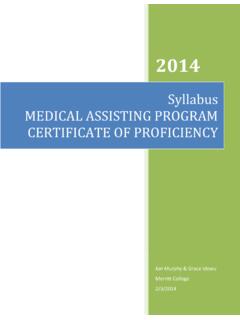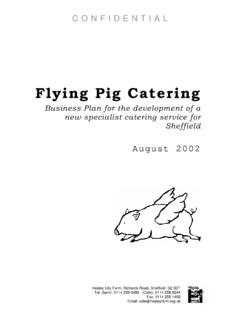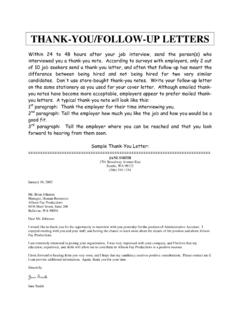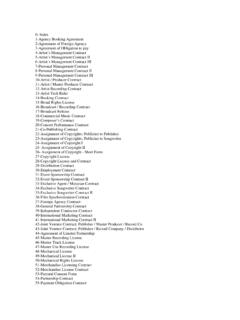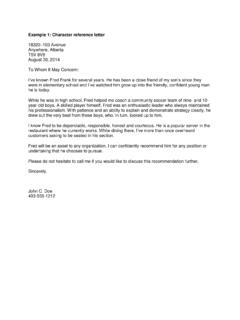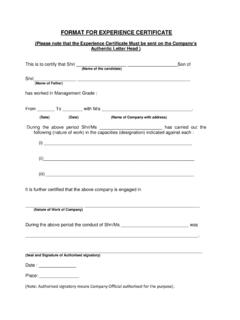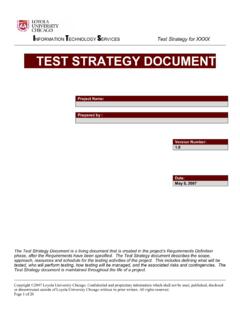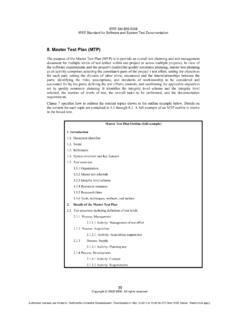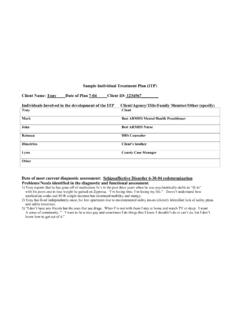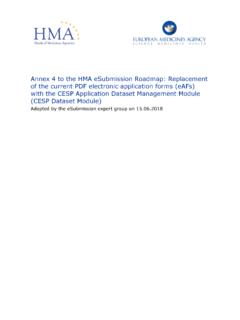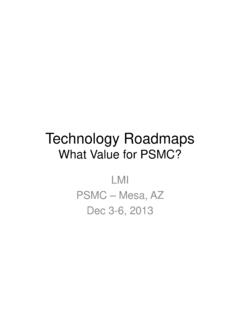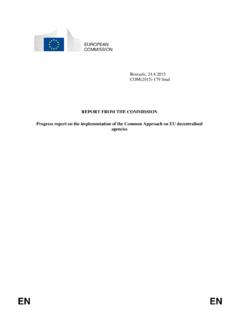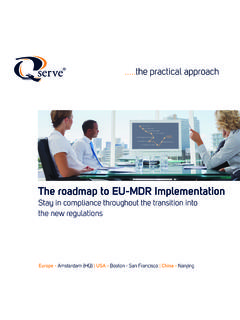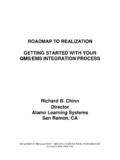Transcription of Developing a Strategic Roadmap - Template.net
1 Developing a Strategic Roadmap Why you need it & how to do it right Session ID# 12509 Juan Porter TopDown Consulting Juan Porter Experience Overview President & Founder of TopDown Consulting Over 25 years experience delivering EPM solutions to numerous Fortune 1000 clients across more than 20 industry verticals Specializations include enterprise performance management, business intelligence, data warehousing, technical architecture, and master data management Regular blogger, frequent speaker, and contributor to various industry publications Chairman, OAUG Hyperion SIG Representative Sample of Clients Adecco AT&T CoBank DirecTV E*Trade Estee Lauder Franklin Templeton Group 1 Automotive HSBC Iron Mountain QAD Pella Shutterfly Take-Two Interactive Wachovia Washington University School of Medicine What is a Strategic Roadmap ?
2 A Strategic Roadmap is a comprehensive framework envisioning, Developing , guiding, and measuring project initiatives Establish Strategic (End State) Vision Identify Project Goals & Objectives Current State Assessment & Architecture Recommended implementation Approach and Scope Preliminary Design High-Level Project Timelines Resource Requirements Preliminary Cost Estimates Identification of Risks and Challenges Definition and Measurement of Success Factors Success Factors Audience Tangibles Experience Realize Executives Ability to perform what-if scenarios quickly Monthly close efficiencies Shorten planning cycle Confidence in reports Improved analysis and forecasting Compliance Report earnings in ?
3 ? days Forecast more accurately Reduce audit fees Execs using Dashboards Project Team Go Live on schedule Get internal recognition Improve data quality # of users on solution Deliver project on time and within budget Become self-sufficient Simplify processes Make users happy Set target date and budget Reduce maintenance by ?? Reduce errors by ?? User satisfaction rating Measure ROI End Users Ability to perform what-if scenarios quickly More time spent on analysis, less on data entry Easy of use Better access to data More timely reporting Less manual input Identify amount of time saved Improve accuracy IT Reduce cost of IT support Verify compliance Ability for internal team to support solution Stable environment Integrate security Fits internal standards Compliance Supportable Achieve internal standards Measure performance Why Do You Need a Roadmap ?
4 To create an internal understanding of how your current solution/process works To identify opportunities for improvement and recommended future state systems and processes To map out an overall implementation approach with a series of achievable initiatives and project wins To improve communication by establishing a common vision and vocabulary To describe the benefits desired from the proposed solution and identify the measures of success To achieve a measurable return on your investment Leading Practices Clearly define vision Driven by CFO, supported by CIO Understand that ERP is not the only source of data Use technology for it s intended purpose Involve the users Know what s needed and how it will be used Challenge the current state encourage change Identify risks and how to mitigate Communicate Change Management Successful Change Management = User Adoption Socialize vision, solution, and new processes Leverage Executive support Identify thought leaders (cheerleaders and detractors)
5 Get buy-in from users at all levels Listen / Empathize Communicate with and involve users throughout project Capture their concerns and ideas EXAMPLES Sample Goals & Objectives To achieve a shared understanding of potential opportunities & areas of improvement Eliminate redundant repositories of data Improve reporting performance and usability Increase confidence in the numbers Leverage existing investment in ERP and other data systems Create self-serve reporting environment where users focus on analysis, not generating reports Reduce administrative complexity by providing automated solutions where possible Current State Assessment Evaluate current processes How did our current process evolve over time?
6 What do we like about the current process? What do we dislike about the current process? Determine what information you need to manage, and how you want to measure it What s important? Alignment with corporate goals and objectives How is this maintained / updated Current State Architecture ERP DW ERP ERP RegA RegB Oper3 Oper4 Dept Oper1 Dept GL Bud/ Fcst Oper2 HFM Corporate Regions Possible Risks Data availability, cleanliness, comparability, and integrity Resource availability Change in reporting requirements Change in organization priorities Dimensionality differences among ERP, DW, HFM, and Essbase Project Timeline & Resources 5121926310172431714212841118254111825181 5222961320273101724181522295121926123456 7891011121314151617181920212223242526272 8293031323334353637383940414243 Installation of Servers and SoftwareRequirements GatheringHFMP arallel TestingFDMC reate GL extractsCreate Data mappingTesting & ResolutionUser TrainingEssbaseDimensionsData IntegrationSecurityParallel TestingApplication Build -Dimensions -Calc Scripts -Load & Reconcile DataMonth 2 Month 3 Month 1 -Load & Reconcile Data -DimensionsApplication Build -Rules and FormulasDesignProject ManagementMonth 10 Month 9 Month 5 Month 4 Month 8 Month 7 Month 6Go-Live -Reports
7 -SecuritySystem Integration TestingTraining, User Testing, and ResolutionGo-Live -ReportsSystem Integration TestingTraining, User Testing, and Resolution -SecurityPLANNING THE PROJECT Understanding the Project Phases Strategic Roadmap Requirements & Design Build Test Deploy Review & Assess Create Strategic vision Analyze current solution & processes Perform gap analysis Identify risks & challenges Identify requirements Define scope & objectives Obtain executive commitment Design applications, data integrations, reports Setup environment Build solution Develop integrations Unit testing Validate data Integration Testing UAT Performance Testing User training Go-live Support Project review Measure success Lessons learned Requirements Indentify and document requirements Business, Users, and IT Evaluate against business purpose Why is a requirement required?
8 How does it help the process, provide insight, or improve the ability to manage? Resolve conflicting requirements Develop high-level design and key benefits Socialize Approve Design the Solution Review Roadmap and Requirements Make sure everyone on same page Separate processes Identify dependencies and key steps Determine accountability and ownership Define solution structure Dimensions, Business Rules, Integrations, etc. Develop prototype to visualize solution Increase understanding and support Mitigate resistance Create Design Document and Project Plan Establish Communication Plan Build the Solution Implement the established design Follow the project plan Closely monitor project Resources Effort to complete tasks and project Budget Contingencies Communicate any changes to design immediately Review with stakeholders and obtain sign-off Maintain transparency Acknowledge success and milestones Bad news does not get better with time Application Development Cycle Adhoc Analysis Accounts Formulas & Business Rules Load Data Entities Scenarios Time Custom Security Data Entry Forms Training &
9 Rollout System Reports Testing Standard Reports Testing the Solution Establish testing processes and identify participants Types of testing Integration Testing Performance Testing User Acceptance Testing Parallels Process Prepare test environment Develop test scripts Train testers Perform test Collect results and make changes as needed Approve results Deploy to Users Prepare the organization for Go Live Transition will demonstrate adoption of solution Preparation: Build sign-off Develop training materials Confirm logistics for training Internal resources are designated for training Process: Constant knowledge sharing with the organization s users Create the training plan and documentation Deliver the training Determine post- implementation support plan Review & Assess Quantify Success Measure achievement of critical success factors Not all improvements are realized at Go Live Demonstrate predicted benefits of the project to stakeholders Build momentum within the organization to begin next phase of the Strategic Vision Capture lessons learned during project common PITFALLS common Pitfalls Effort to reconcile data Data is never as clean as you might expect Internal Audit not engaged Lack of defined roles between Finance and IT Admin and Users New technology.
10 Same old process Underestimating change management Questions? Comments? THANK YOU Juan Porter President & Founder, TopDown Consulting
